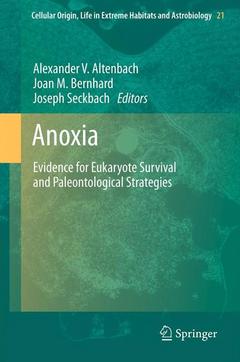Description
Anoxia, 2012
Evidence for Eukaryote Survival and Paleontological Strategies
Cellular Origin, Life in Extreme Habitats and Astrobiology Series, Vol. 21
Coordinators: Altenbach Alexander, Bernhard Joan M., Seckbach Joseph
Language: EnglishPublication date: 11-2013
648 p. · 15.5x23.5 cm · Paperback
Publication date: 10-2011
648 p. · 15.5x23.5 cm · Hardback
Description
/li>Contents
/li>Comment
/li>
Introduction, Joseph Seckbach. Stepping into the book of Eukaryotes and Anoxia, Alexander Altenbach, Joan Bernhard, Joseph Seckbach. List of Authors and their Addresses. List of External Reviewers and Referees. Acknowledgment to authors, reviewers and any special people who assisted.
PART I: GENERAL INTRODUCTION
Anaerobic eukaryotes, Tom Fenchel. Biogeochemical reactions in marine sediments underlying anoxic water bodies, Tina Treude. Diversity of anaerobic prokaryotes and eukaryotes – breaking long-established dogmas, Aharon Oren.
PART II: FUNCTIONAL BIOCHEMISTRY
The biochemical adaptations of mitochondrion-related organelles of parasitic and free-living microbial eukaryotes to low oxygen environments, Anastasios Tsaousis et al. Hydrogenosomes and mitosomes: mitochondrial adaptations to life in anaerobic environments, Rob De Graaf and Johannes Hackstein. Adapting to hypoxia: lessons from vascular endothelial growth factor, Nina and Andy Levy.
PART III: MANAGING ANOXIA
Magnetotactic protists at the oxic-anoxic transition zones of coastal aquatic environments, Dennis A. Bazylinski et al. A novel ciliate (Ciliophora: Hypotrichida) isolated from bathyal anoxic sediments, David J. Baudoin et al. The wood-eating termite hindgut: diverse cellular symbioses in a microoxic to anoxic environment, Michael F. Dolan. Ecological and experimental exposure of insects to anoxia reveals suprising tolerance, William W. Hoback. The unusual response of encysted embryos of the animal extremophile, Artemia franciscana, to prolonged anoxia, James S. Clegg. Survival of tardigrades in extreme environments – a model animal for astrobiology, Daiki Horikawa. Long-term anoxia-tolerance in flowering plants, Robert M.M. Crawford.
PART IV: FORAMINIFERA
Benthic Foraminifera: inhabitants of low-oxygen environments, Karoliina Koho and Elisa Piña-Ochoa. Ecological and biological response of benthic Foraminifera under oxygen-depleted conditions: evidence from laboratory approaches, Petra Heinz and Emmanuele Geslin. The response of benthic Foraminifera to low-oxygen conditions of the Peruvian oxygen minimum zone, Jürgen Mallon et al. Benthic foraminiferal communities and microhabitat selection on the continental shelf off central Peru, Jorge Cardich et al.
Living assemblages from the “Dead Zone” and naturally occurring hypoxic zones, Kurt R. Buck et al. The return of shallow shelf seas as extreme environments: Anoxia and macrofauna reactions in the northern Adriatic Sea, Michael Stachowitsch et al. Meiobenthos of the oxic/anoxic interface in the south-western region of the Black Sea: abundance and taxonomic composition, Nelli G. Sergeeva et al. The role of eukaryotes in the anaerobic food web of stratified lakes, Alessandro Saccà. The anoxic Framvaren fjord as a model system to study protistan diversity and evolution, Thorsten Stoeck and Anke Behnke. Characterizing an anoxic habitat: sulphur bacteria in a meromictic alpine lake, Giesela Fritz et al. Ophel, the newly discovered hypoxic chemolitho-autotrophic groundwater biome - a window to ancient animal life, Franzis Dov Por. Microbial eukaryotes in the marine subsurface? Virginia P. Edgcomb and Jennifer Biddle.
PART VI: MODERN ANALOGS AND TEMPLATES FOR EARTH HISTORY
On the use of stable nitrogen isotopes in present and past anoxic environments, Ulrich Struck. Carbon and nitrogen isotopic fractionation in Foraminifera: possible signatures from anoxia, Alexander V. Altenbach et al. The functionality of pores in benthic Foraminifera in view of bottom water oxygenation. A review, Nicolaas Glock et al. Anoxia-dysoxia at the sediment-water interface of the southern Tethys in the late Cretaceous: Mishash formation, southern Israel, Ahuva Almogi-Labin. Styles of agglutination in benthic Foraminifera from modern Santa Barbara basin sediments and the implications of finding fossil analogs in Devonian and Mississippian black shales, Jürgen Schieber. Did redox conditions trigger test templates in Proterozoic Foraminifera? Alexander V. Altenbach and Maren Gaulke. The relevance of anoxic and agglutinated benthic Foraminifera to the possible Archean evolution of eukaryotes, Wladyslaw Altermann et al.
PART VII: FINALS.
Reveals eukaryotic strategies in anoxic environments
Includes cutting-edge research, data and hypotheses never before published
Offers also fundamental introductions, overviews and an exhaustive collection of literature for advanced studies
These books may interest you

(Endo)symbiotic Methanogenic Archaea 105.49 €

Processes in Microbial Ecology 39.35 €

Processes in Microbial Ecology 121.51 €


